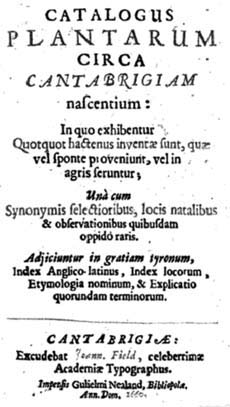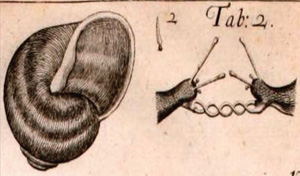|
This year marks the 350th anniversary of a significant event in the history of malacology. In 1660, English naturalist John Ray published his first book, Catalogus plantarum circa Cantabrigiam nascentium, which was an annotated list of the plants of Cambridgeshire. The annotations included not only information about the plants themselves but also occasional digressions on not so related subjects. Hence, hidden under the deadly nightshade (Atropa belladonna) was a little gem2:- ‘Not even this lethal plant escapes the teeth of snails and slugs for its leaves are freely eaten in spring by these creatures. In passing one may mention that they are hermaphrodite. That they alternately function as male and female by impregnating and receiving at the same time will be clear to anyone who separates them as they are having intercourse in Spring, although neither Aristotle nor any other writer on Natural History has recorded this fact.’ We shouldn’t be surprised that Ray revealed his discovery of land snail hermaphroditism in a book about plants. That was a time when the boundaries between the branches of science were still hazy and many scientists were versed in botany, zoology, geology, meteorology, medicine and other fields. Not surprisingly, Ray’s subdued announcement didn’t escape the attention of his fellow mollusc enthusiasts during the following decade. When in 1670 the Royal Society’s incipient journal Philosophical Transactions reviewed Dutch anatomist Jan Swammerdam’s 1669 book Historiae Generalis Insectorum3,4 and mentioned that according to Swammerdam ‘Snails discharge their excrements by the neck, and are each of them, both Male and Female’, the polymath Dr. Martin Lister made a point of reaffirming Ray’s priority in a letter published in the same journal the following year5: ‘…when I read in the Account given us by you of [Swammerdam’s] Book, Numb. 64; that Snails are both Male and Female; that Caterpillars may teach us, by their feeding, the correspondence of the vertues of Plants, &c; I am desirous to know, whether he quote Mr. Ray for the former, as having publish’t the Observation ten years ago at least…’ Swammerdam had indeed acknowledged Ray’s precedence, but without mentioning his name3: ‘But we must also add here that this English gentleman, who has described the new plants growing around Cambridge, has also found by experiment that the snails are male & female together.’ That was probably good enough for the more relaxed standards of the period. Swammerdam also put a drawing of a pair of mating snails on the cover of his 1667 doctoral thesis De Respiratione, although that was apparently out of context, because his work was about respiration6. Others followed in Ray’s and Swammerdam’s footsteps. In a book published in 1679, Swiss physician Johann Jacob Harder wrote about snail anatomy and mentioned their hermaphroditism, citing Swammerdam only7. Almost 300 years later, Libbie Hyman erred in her extensive review of the malacological literature and credited Harder for the discovery of snail hermaphroditism8. Heppell, however, was more careful in his brief history of malacology and affirmed Ray’s priority9. Meanwhile, Lister published his drawing of mating hermaphrodite snails in 167810 (Fig. 1). Note that the plate in Lister’s book was reversed during printing, which was a common practice during that time11. Thus, all the shells are sinistral. Also, the mating snails are not properly oriented (neither are those of Swammerdam6); normally, the snails would have the right sides of their heads, where a dextral snail has its genital opening, against each other. There are two ways to determine if a species is a hermaphrodite. First, one may dissect and compare the genitalia of many individuals. If everyone is found to have the same set of reproductive organs, one will assume that they all are hermaphrodites and then try to identify the male and female parts. Second, one may watch or separate mating pairs. If one happens to see that each individual in a pair is using its penis simultaneously to inseminate its partner, one will then conclude that they all are hermaphrodites. Ray used the second method. And he was lucky that the mating of the snails he separated, probably a large Helix species, was simultaneously reciprocal. We now know that in some species of pulmonates, even though they all are hermaphrodites, sperm exchange is not reciprocal and only one individual is the ‘donor’, while the other is the ‘receiver’12. Had Ray happened to interrupt the mating of such a species, he would not have discovered that they were hermaphrodites. Notes 1Section of Mollusks, Carnegie Museum of Natural History, Pittsburgh, Pennsylvania, USA. pulmonate@earthlink.net 2 John Ray. 1660. Catalogus plantarum circa Cantabrigiam nascentium. (The quote is from the 1975 English translation, Ray’s flora of Cambridgeshire by A. H. Ewen and C. T. Prime. Welden & Wesley.) Ray’s original is available from Google Books: http://tinyurl.com/yk2j55t. 3Jan Swammerdam. 1669. Historia insectorum generalis. Available from Google Books: http://tinyurl.com/yfkrg7r. (The quote is my translation from the 1685 French edition, Histoire Générale des Insectes. Available at http://tinyurl.com/ygrmbx4.) 4Anonymous. 1670. An Accompt of Some Books. Philosophical Transactions 5:2074-2082. 5Martin Lister. 1671. A Letter of Mr. Martin Lister, Written at York August 25 1671, confirming the Observation in No 74. about Musk Sented Insects; adding some Notes upon D. Swammerdam’s book of Insects, and on that of M. Steno Concerning Petrify’d Shells. Philosophical Transactions 6:2281-2284. 6A picture of the cover of Swammerdam’s De Respiratione is available at http://tinyurl.com/yfejb8d. 7Johann Jacob Harder. 1679. Examen anatomicum cochleae terrestris domiportae. Available from Google Books: http://tinyurl.com/ygc86gm. 8Libbie Hyman. 1967. The Invertebrates, volume VI, Mollusca I. McGraw-Hill. 9David Heppell. 1995. The long dawn of malacology: a brief history of malacology from prehistory to the year 1800. Archives of Natural History 22:301–319. 10Martin Lister. 1678. Historiae animalium Angliae tres tractatus. Available from the Biodiversity Heritage Library: http://tinyurl.com/ykwrnfr. 11Warren D. Allmon. 2007. The evolution of accuracy in natural history illustration: reversal of printed illustrations of snails and crabs in pre-Linnaean works suggests indifference to morphological detail. Archives of Natural History 34:174-191. 12Aydin Örstan. 2009. An observation of the mating of Chondrus tournefortianus (Pulmonata: Enidae). Zoology in the Middle East 48:117-118. Available at: http://tinyurl.com/yhn88qu. |
Figure 1: Drawing of the heads of mating snails from Martin Lister’s 1678 book. Also shown are a shell and a love dart. The image was reversed during printing.
|
John Ray’s hermaphrodite snails on their 350th anniversary
Issue
23
Page
3


